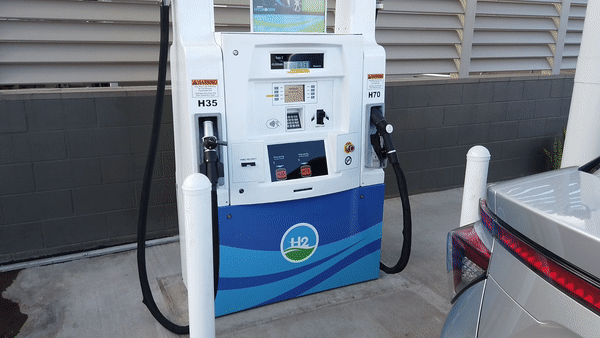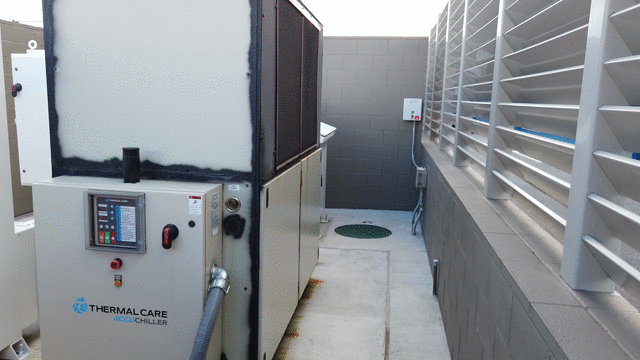
A fuel that can help fix climate change, but it'll take time
By: Troy Jacobs
7 November 2019
Courtesy: Mitch Ewan
Courtesy of: Troy Jacobs
Hydrogen fuel is changing the game in the automotive industry, but people are still unaware about its use.
A fuel-cell vehicle (FCV) is powered by hydrogen, which is one of the most abundant elements in the world since it’s made from water.
FCVs have been around for decades, but automotive companies assembled limited amounts of FCVs and were not available to the public since gas-powered vehicles and fueling stations were already well-established.
In 1992, Toyota developed the Mirai, a FCV, according to Servco Toyota Hawaiʻi’s Senior Vice President Thor Toma.
In October 2015, the Mirai was shipped from Japan to Hawaiʻi but wasn’t available for the public because Hawaiʻi didn’t have any hydrogen fueling stations.
In October 2018, Servco Toyota Hawaiʻi built the first publicly accessible hydrogen fueling station and allowed the public to lease the Mirai for $350 per month for three years. The only states that carry the Mirai are California and Hawaiʻi.
Currently, there are about 17 Mirai owners on Oʻahu.
Servco Toyota also provides Mirai drivers with free hydrogen fuel at their onsite fueling station. The Mirai can travel about 300 miles on a full tank of hydrogen. The fueling station is designed for self-service, but Mirai owners need to contact Servco Toyota in advance to refuel their FCV.
Mitch Ewan, hydrogen systems program manager at the Hawaiʻi Natural Energy Institute, has been working with hydrogen after he left the Navy in 1986. Ewan says hydrogen is one of the cleanest fuels in the world since it’s made entirely from water and electricity.
“It’s the most common element in the universe,” said Ewan. “So we have oceans of water that will never run out of hydrogen. The sun is basically hydrogen. So like I said, it’s the most prevalent element in the universe.”

Hydrogen is separated from water through a process called electrolysis, which uses electricity to split water molecules into oxygen and hydrogen gases. The hydrogen is then stored in high pressure steel tanks and transported to hydrogen fueling stations, while the oxygen is released into the atmosphere.
Hydrogen is normally made at an industrial site. But Servco makes their hydrogen from an electrolyzer machine that’s located behind their fueling station.
The hydrogen fueling station at Servco Toyota in Mapunapuna
“People are probably a little bit cautious about buying a car and knowing that there aren’t a lot of hydrogen fueling stations around where they can just fill it anytime they want,” said Ewan. “They all have to come back to Mapunapuna to fill their car.”
According Toma, Servco Toyota funded and built the station to show the public that hydrogen is a reliable and sustainable fuel source.
“What we wanted to do is show people what’s possible,” said Toma. “It’s hard when you look at the pictures in a book or see a video to really imagine how it can work. Hydrogen is not science fiction or a science experiment, it’s real.”
Since the Mirai came onto the market, FCVs are slowly catching on with the public. But people are still skeptical about what hydrogen is.
Ewan says that every fuel is flammable and should be treated with respect but hydrogen is considered to be one of the safest fuels.
“Hydrogen is so light that it naturally wants to escape and goes up at about 45 mph, whereas gasoline vapors are heavier than air and just sits around the car,” Ewan said.
A common myth about electrolysis is that the process uses electricity from only fossil fuels to separate the water molecules. According to Ewan, renewable energy sources such as solar, wind, ocean and geothermal generate electricity to perform electrolysis.
Servco's fueling station currently uses electricity provided by the Hawaiian Electric Company to perform electrolysis. According to Toma, Servco is building solar panels near their fueling station to provide electricity.
Hawaiʻi’s lawmakers are also giving attention to hydrogen, according to Hawaiʻi Revised Statute 196-10.
“We've been getting a lot of support from our lawmakers,” said Ewan. “Just so you know, it’s the law in our revised statutes. It says that Hawaiʻi shall evolve to a hydrogen economy.
As for the 17 people that drive Mirais on Oʻahu, Toma says the feedback Servco gets is great.
“They love the car,” said Toma. “Those are the people that are really interested in technology and the environmental aspects of hydrogen vehicles.”
If the demand for FCVs rise then Hawaiʻi could see more hydrogen fueling stations and possibly more FCVs from other automobile manufacturers.

Hydrogen is then pumped into the FCV and stored in a pressurized tank. When the vehicle starts, hydrogen is sent into a fuel-cell stack and mixed with oxygen from the air outside, creating electricity that powers an electric motor. The only by-product the vehicle emits is water vapor.
If hydrogen is one of the cleanest fuels, why is it taking longer to catch on with the public? Ewan says it’s the lack of fueling stations.
Oʻahu currently has three hydrogen fueling stations — two of which are on private military bases. The only station that’s available to the public is at Servco Toyota in Mapunapuna.
California has a few hydrogen fueling stations but plans to expand that by 2025.
The electrolyzer machine that's behind the fueling station. This machine performs electrolysis to make hydrogen.


